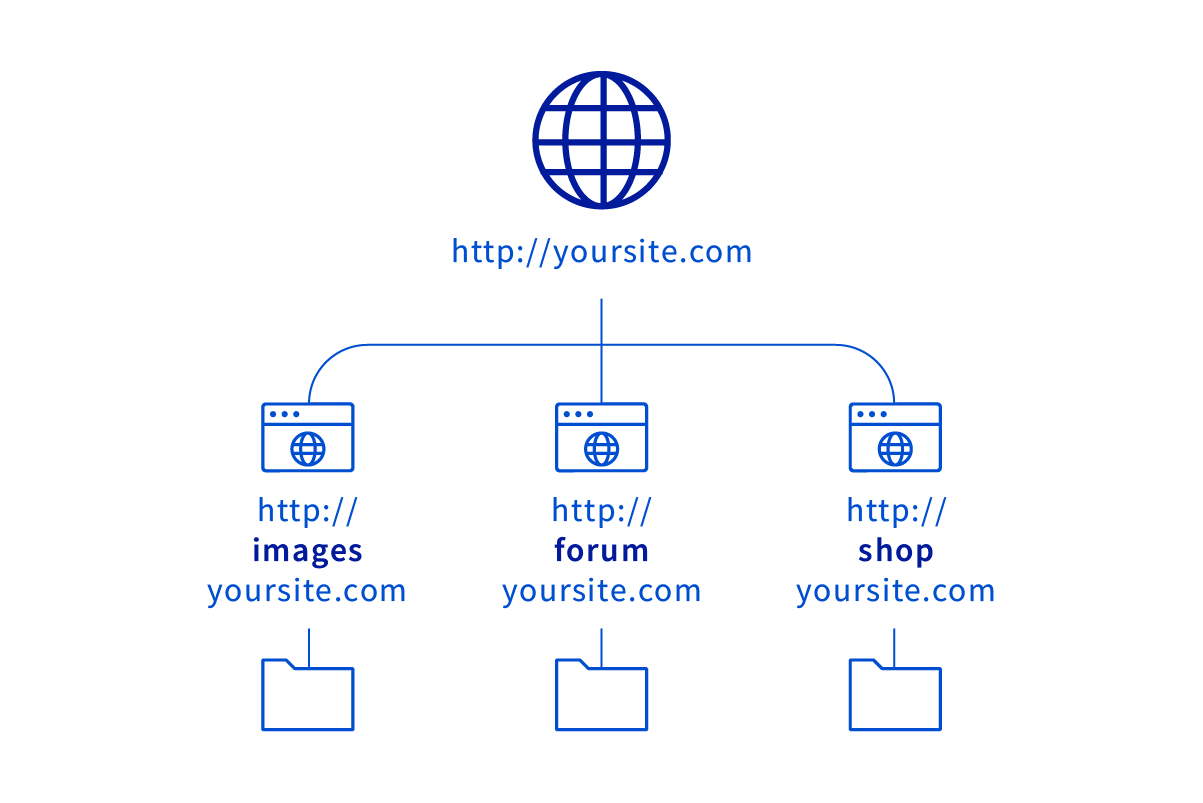Subdomains are a great way to organize and manage your website’s content. They can be used to create a separate and distinct website for each section of your website.
Nowadays, there are many website platforms that provide different domain names for different purposes. In such cases, it is best to use a subdomain for your website.
If you’re not using subdomains for your website, you’re missing out on a great opportunity to improve your website’s organization and search engine optimization (SEO). In this blog post, we will learn thoroughly about subdomains and why you should use them in your website.
Let’s start from scratch!
What is a Subdomain?
A subdomain is a second-level domain, which is a part of the main domain. It is used to logically organize website content. Subdomains can be used to organize different sections for specific content types of your website, and they can also be used to target different keywords.
For instance, if your website is “tezhost.com”, you can use the subdomain “blog.tezhost.com” for your blog. By using a subdomain, you can keep your blog separate from your website. You can use a subdomain for your blog, another for your e-Commerce store, and another for your company’s contact information.
How to Create a new subdomain?
The majority of control panels give you an easy way to add additional subdomains. For the majority of control panels, the procedure for creating a subdomain is generally the same. Here’s how to accomplish it in cPanel as an illustration:
1. Enter the login information your host gave you when you registered your domain and go to cPanel.

2. After scrolling to the “Domains” section click “Subdomains”

3. Fill in the box with the name of the new subdomain you want to create.
4. Choose the domain for which a subdomain is needed.
5. You can select any add-on or parked domains you’ve created from the drop-down menu.
6. Enter the path to the domain’s document root as per required.

How do subdomains work?
Subdomains work by redirecting visitors from your main domain to the subdomain. When a visitor types in your main domain name, they are automatically redirected to the subdomain. For example, if a visitor types in “example.com”, they will be redirected to “blog.example.com”.
You can also use subdomains to create separate versions of your website for different countries or languages. For example, you could have a version of your website in French and another in English.
To create a subdomain, you will need to add a DNS record to your DNS settings. DNS is the system that converts domain names into IP addresses. By adding a DNS record, you are telling the DNS system where to find your website.
To add a DNS record, you will need to log in to your DNS settings and add a new “A” record. The “A” record is a DNS record that points to an IP address. In the “A” record, you will need to specify the IP address of your subdomain.
For example, if your subdomain is “blog.example.com” and you want it to point to the IP address “192.168.1.1”, you would add the following DNS record:
blog.example.com. IN A 192.168.1.1
Once you have added the DNS record, you will need to wait for the DNS changes to propagate. DNS changes can take up to 24 hours to propagate worldwide.
Benefits of using subdomains
Following are the 6 benefits of subdomains:
Improve Search Engine Organization (SEO)
If you’re not using subdomains for your website, you’re missing out on a great opportunity to improve your website’s organization and search engine optimization (SEO). Subdomains can be used to organize different sections of your website, and they can also be used to target different keywords
Improve Site Organization
It’s crucial to keep your websites organized if you want to make it simpler for visitors to your site to find what they’re looking for. You can place specific themes on their own subdomain so they show up as their own part on your main page if you have a complicated website with many pages.
This makes it possible to create a site map that is organized throughout all of your website’s sections and also makes it possible for users to get to certain pages without doing a lot of pointless scrolling.
Maintain Brand Consistency
You want to preserve your brand’s image and consistency across all platforms, which is one of the most crucial things you can do. By using a subdomain, you can maintain consistency across all of your branding elements while also ensuring that each of your websites is somehow related to the others.
Same indexing by search engines
Subdomains are essentially smaller websites, thus search engine bots will crawl them just like any other website. This implies that you can gain from having certain pages rank well when people browse for more specific themes or keywords, in addition to your website appearing when people search for your company name.
Enhanced Subdomain Promotion On Social Media
You can advertise a subdomain on social media platforms because it is a particular website inside of a larger one. By doing this, you may find people who are specifically interested in the subject at hand and direct them to your site rather than having them connect to it or search for your company name.
Different Types of content
Even when you’re providing all the information about your products or services, having many pages on the same website with the same exact information can seem a little monotonous.
This issue is resolved by a subdomain, which enables you to have a single site with various pages that are dedicated to various aspects of your business.
Various Geographic Areas
When presenting information on your website regarding services and products offered in a certain area, you might wish to target that location explicitly if your small business has a physical facility there. This is made possible via a subdomain, which enables you to create a site for each distinct region that is only accessible to those in that region.
By directing people who are geographically close to you directly to your business, you can further target your advertising efforts and make it simple for visitors to access the information they need without having to navigate through any of your other websites.
Conclusion
In conclusion, using subdomains is a terrific approach to managing and organizing the content of your website. Each component of your website can be used to build a different and unique website. There are several website platforms available nowadays that offer various domain names for various uses. It is preferable to use a subdomain for your website in such circumstances. You’re missing out on a terrific chance to organize your website better and boost its SEO if you don’t use subdomains for your website (SEO).
Hopefully, this blog post helped you in understanding all about subdomains. For more information on Domain, head on to our Blogs section!


